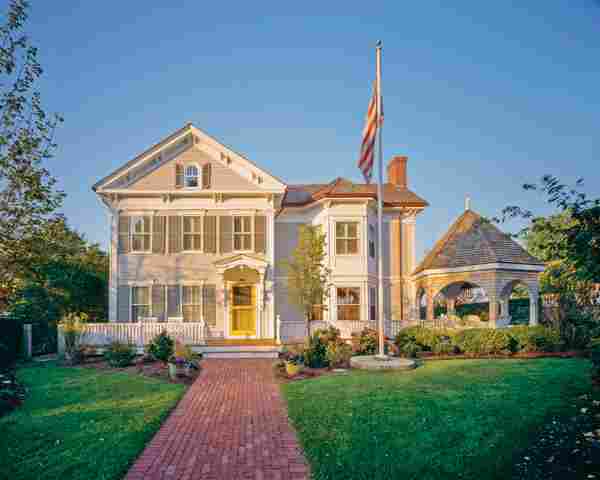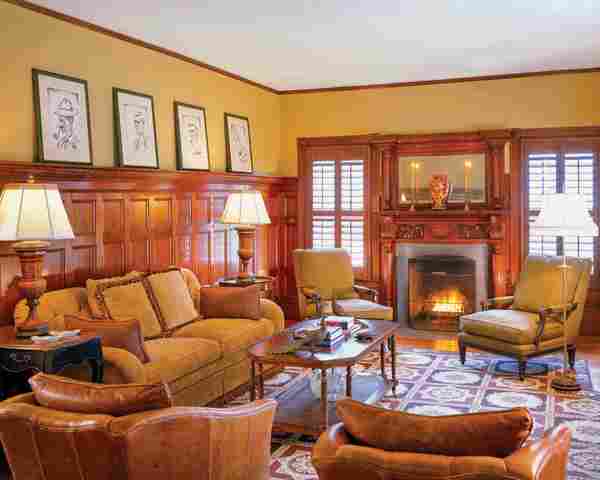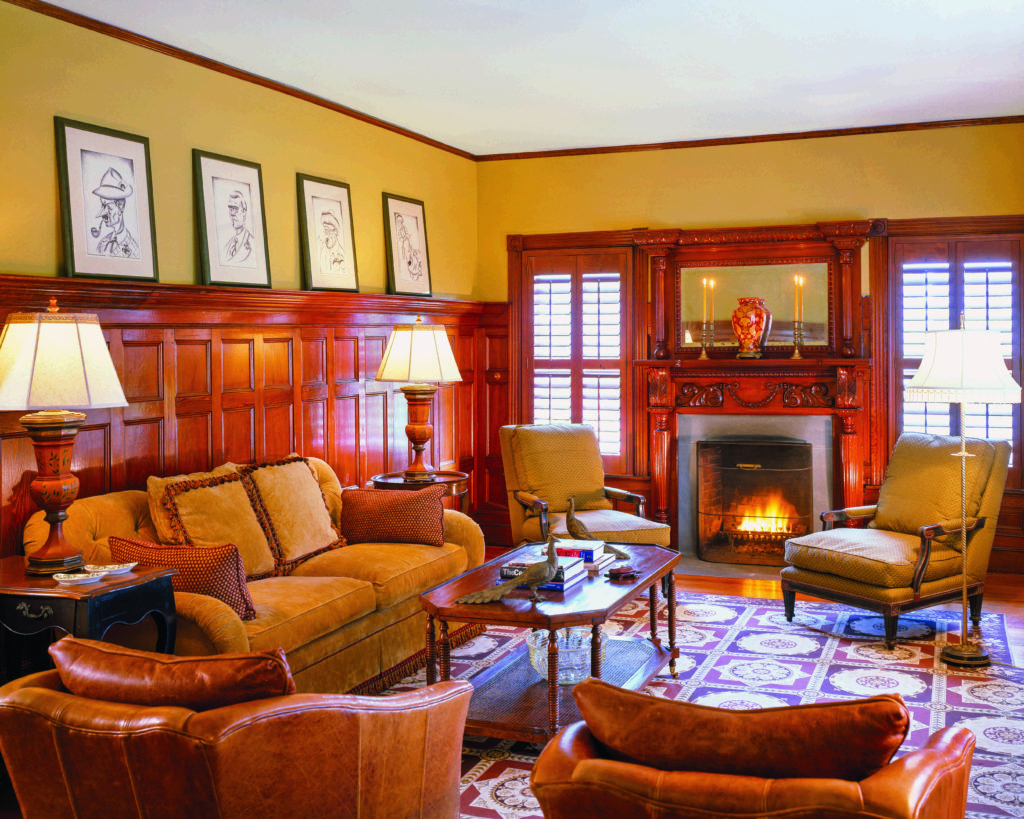
The handsome gable front-and-wing Italianate house faces the street, boasting mid-19th century details such as deep roof and front entry brackets. The Victorian original nicely co-exists with elements added in 1901, including the attached gazebo.
Brian Vanden Brink
On main street in Chatham, Massachusetts, stands a handsome Italianate house, built in 1864. Just a short walk from the harbor, it has been a local landmark for many years, what with its ornate brackets at the entry, its pediment gable, and its big shuttered windows.
“Cape Cod has not, in general, had many eras of wealth,” explains architect John DaSilva, principal of Polhemus Savery DaSilva Architects Builders in Chatham. “The historic houses are spread out—and this one’s unusual on the Cape. It’s located in a village, where lots of people walk by on their way to the beach, so it’s loved by many.”
The Italianate became the retirement home of Admiral Charles Rockwell in 1901. He built the octagonal gazebo, prominent at the front corner, and added a bedroom wing at the rear. The admiral dubbed his house The Moorings and the name stuck. Expanded to 3,695 square feet, the house became an inn sometime later. It was operating as an inn when current owner John Keogh, a Bostonian, bought it a few years ago.

When John Keogh bought the house, the kitchen was utilitarian, designed for serving breakfast to inn guests. John DaSilva did considerable work to rebuild the room for the needs of the family, adding the center island and a breakfast nook. Period elements include beadboard and bin pulls, stone countertops, and reproduction pendant lights.
Brian Vanden Brink
“I’d been looking for a vacation home in Chatham,” John says. He says he’d noticed the house over the years, admiring its beautiful landscape of shrubs and gardens, though he’d never been inside. When the bed-and-breakfast inn owners decided to retire, his agent arranged an early walk-through and the transaction went quickly. “I knew it was going to be a big restoration project,” he says, “but it was absolutely the right house for me.”
The design–build company Polhemus Savery DaSilva has a well-earned local reputation for their work on old houses. (They’d also restored Serenity Bluff in Osterville and Hydrangea Walk and Riptide in Chatham, all notable Cape Cod properties.) “The Moorings is iconic,” DaSilva says. “The house was beautifully designed; it was thrilling for me to be able to bring it back.”
Over the years, the shutters had been removed, the round-top gable window cut down to a rectangular opening, and the quintessential Italianate front entry removed in favor of Colonial Revival pilasters and a door hood. Then the interior was modified to suit the inn, “which maximized bedrooms and sacrificed common space,” says owner John Keogh. “In the back addition, there was a closet with a closet in it. We stripped away the odd additions and rebuilt the back extension, while staying within the footprint of the building I purchased.”
DaSilva says the house was not in bad shape, structurally. The team removed sliding glass doors and other unsympathetic add-ons. They found archival photos of the house at the local historical society, which provided guidance for replacing the porch hood and brackets and the shutters on the façade.
“This was a fine Italianate house,” DaSilva explains, “—but it’s not rare or unusual. Even the elaborate brackets were available from catalogs when the house was built.”
DaSilva believes that the ell or wing to the right of the gabled main house dates to the 1864 original construction. “The arch leading from the front hall into the paneled living room looks more 19th century than early 20th century,” he says. “And the moulding profile of the arch occurs elsewhere in the house.”

The living room, which occupies the front of the wing, retains its handsome original fir flooring and oak paneling, a testament to the economic status of the first owner. Today the room is furnished with traditional, comfortable upholstered pieces. The carved mantelpiece with columns and mirrored overmantel is original to the house, as is the stone surround. Polhemus Savery DaSilva refinished the oak paneling.
Brian Vanden Brink
The living room and dining room in the front of the house needed little more than paint. The kitchen in the rear addition, however, was substantially rebuilt. DaSilva specified a new arch leading to the kitchen. The old inn kitchen—set up to serve breakfast to guests—was redone to serve a family. A new doorway with round-top windows leads to the large terrace.
“We didn’t have any photos of the side of the house. So we created a side-porch roof inspired more by the house’s Shingle Style elements, to honor all of its history as we added another layer.”
The firm installed new plumbing, electrical system, and air conditioning, and rebuilt the house’s four and a half bathrooms. The master suite, which is above the living room, echoes the living-room window bay and fireplace. John Keogh asked his architect to design a guest bedroom on the first floor for his mother. For walls throughout, he chose soft yellows, greens, and blues, then furnished rooms with a comfortable combination of traditional upholstered pieces and Stickley re-issues of American Arts & Crafts furniture. He says he’s very much at home here now, spending summers and holidays in the company of his mother, siblings, nieces, and grand-nieces.
“Someday, I might move my collection of nautical antiques here from Boston,” Keogh says. “They’d fit in very nicely with the history of this house.”

“The Moorings”
Brian Vanden Brink
Layered History on the Porch
The eight-sided gazebo at the front corner of the house was most likely added by Admiral Rockwell during his ca. 1901 renovation, as evidenced by its allusion to Shingle Style. It’s part of a broad porch, just recently rebuilt, that dates to the work at the turn of the 20th century. The gazebo bumpout is at the intersection of the house’s façade and right side. Over a hundred years, the little structure has become a beloved feature in the neighborhood—as much a part of the history of the house as its Italianate elements. “We did remove non-historical features, which had accumulated in the years after the admiral’s days,” DaSilva says. That included an inappropriate two-storey porch and a sliding glass door. Clapboards sheathe the original 1864 house, but later sections dating to ca. 1901—the gazebo and rear bedroom wing—are clad in cedar shingles.










